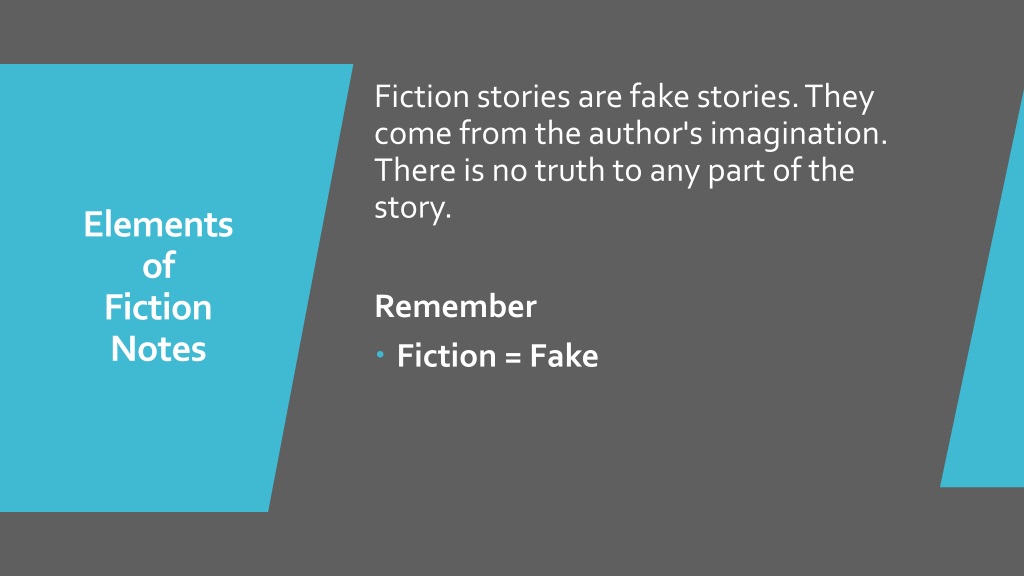

0 likes | 3 Views
In fiction, stories are fake and come from the author's imagination. The setting, characters, plot, conflict, and point of view are key elements to consider. Characters can be dynamic, static, flat, or round, each serving a different role in the narrative. Understanding different types of conflicts like internal and external adds depth to the storytelling. The author's message or theme is essential in conveying the underlying lesson to the readers. Explore various types of fiction stories such as historical fiction and science fiction, each offering unique storytelling opportunities.

E N D
Fiction stories are fake stories. They come from the author's imagination. There is no truth to any part of the story. Elements of Fiction Notes Remember Fiction = Fake
Setting ALWAYS contains two criteria. • Place = Where? • Time = When? USE Context clues to figure out the setting. SETTING If you are not sure about the exact time, use PAST, PRESENT, or FUTURE.
People Animals Imaginary creatures that take part in the story CHARACTERS
PROTAGNOGIST = Main character ANTAGONIST = the person against the main character MAIN CHARACTER = the character the story revolves around MINOR CHARACTER = the character who is there to build background Types of Characters DYNAMIC CHARACTER = a character who changes from the beginning of the story STATIC CHARACTER = a character who stays the same, never changes FLAT CHARCTER = a character the reader only knows one or two things about ROUND CHARACTER = a character the readers knows everything about
The method the author uses to create characters 1. Setting 2. Physical appearance 3. What the character says 4. What the character does 5. What the character thinks CHARACTERIZATION 6. How the character feels 7. What other characters say about that character 8. What other character do to that character 9. What other characters think about that character 10. How other characters feel about that character 11. What the author says about the character
SEQUENCE of EVENTS in the STORY PARTS of the PLOT PLOT 1. EXPOSITION introduces the characters, setting and conflict 2. RISING ACTION the complications related to the conflict 3. CLIMAX the turning point of the story 4. FALLING ACTION is the wrapping up of the conflict 5. RESOLUTION the conflict is solved Or CONCLUSION the conflict is not solved
CONFLICT=PROBLEM Two Types of Conflict • INTERNAL CONFLICT = Character vs. Himself or herself CONFLICT • EXTERNAL CONFLICT = Character vs. Character Character vs. Society Character vs. Nature
The perspective from which the story is told FIRST PERSON POINT of VIEW • The narratoris part of the story • Uses the pronouns I, me, my, we, us POINT of VIEW SECOND PERSON POINT of VIEW • Used in manuals, self-help books, recipes, etc • Uses the pronoun you (usually understood) THIRD PERSON POINT of VIEW • The narrator is not in the story • Uses the pronouns he, she, they, them,
Third Person Limited • Reader only knows what ONE character thinks and feels. Types of Third Person Point of View Third Person Omniscient • Reader knows what ALL of the characters think and feel. Third Person Objective • The reader knows the action, but not what the characters think or feel.
The underlining message the author is trying to get across. The lesson the author is trying to explain. For example: • Don't judge a book by its cover. • Good vs evil...Goodalways wins. • Perseversance paysoff. • Kindness is rewarded. THEME
REALISTIC FICTION = made up stories that seem real but are made up. Types of Fiction Stories HISTORICAL FICTION = made up stories that are based on something that happened in history, but something is changed or added SCIENCE FICTION = made up stories that are based on something that deals with science
Cause and Effect What is the reason something happened? What is the result of the thing happening? Problem and Solution What is the problem and how is it solved? Text Structures Compare and Contrast How are things similar? How are things different? Sequence of Events What are the steps in order?